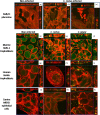Characterization of the invasive and inflammatory traits of oral Campylobacter rectus in a murine model of fetoplacental growth restriction and in trophoblast cultures
- PMID: 20089314
- PMCID: PMC2904603
- DOI: 10.1016/j.jri.2009.11.003
Characterization of the invasive and inflammatory traits of oral Campylobacter rectus in a murine model of fetoplacental growth restriction and in trophoblast cultures
Abstract
Campylobacter species (C. jejuni, C. fetus) are enteric abortifacient bacteria in humans and ungulates. Campylobacter rectus is a periodontal pathogen associated with human fetal exposure and adverse pregnancy outcomes including preterm delivery. Experiments in pregnant mice have demonstrated that C. rectus can translocate from a distant site of infection to the placenta to induce fetal growth restriction and impair placental development. However, placental tissues from human, small-for-gestational age deliveries have not been reported to harbor C. rectus despite evidence of maternal infection and fetal exposure by fetal IgM response. This investigation examined the temporal relationship between the placental translocation of C. rectus and the effects on fetal growth in mice. BALB/c mice were infected at gestational day E7.5 to examine placental translocation of C. rectus by immunohistology. C. rectus significantly decreased fetoplacental weight at E14.5 and at E16.5. C. rectus was detected in 63% of placentas at E14.5, but not at E16.5. In in vitro trophoblast invasion assays, C. rectus was able to effectively invade human trophoblasts (BeWo) but not murine trophoblasts (SM9-1), and showed a trend for more invasiveness than C. jejuni. C. rectus challenge significantly upregulated both mRNA and protein levels of IL-6 and TNFalpha in a dose-dependent manner in human trophoblasts, but did not increase cytokine expression in murine cells, suggesting a correlation between invasion and cytokine activation. In conclusion, the trophoblast-invasive trait of C. rectus that appears limited to human trophoblasts may play a role in facilitating bacterial translocation and placental inflammation during early gestation.
Copyright 2009 Elsevier Ireland Ltd. All rights reserved.
Figures


References
-
- Abrahams VM, Bole-Aldo P, Kim YM, Straszewski-Chavez SL, Chaiworapongsa T, Romero R, Mor G. Divergent trophoblast responses to bacterial products mediated by TLRs. J. Immunol. 2004;173(7):4286–4296. - PubMed
-
- Allos BM. Campylobacter jejuni infections: update on emerging issues and trends. Clin. Infect. Dis. 2001;32(8):1201–1206. - PubMed
Publication types
MeSH terms
Substances
Grants and funding
LinkOut - more resources
Full Text Sources
Medical

